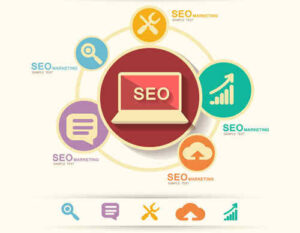Running a successful eCommerce business doesn’t just happen by chance: It takes a lot of hard work and dedication to get to the top.
But even after such hard work, including the financial stress, a lot of eCommerce store owners made many mistakes along the way: some were lucky to bounce back and scale through, but others simply couldn’t recover from such fatal mistakes.
To be on the safer side and ensure that your hard-earned progress is not hampered along the line, you have to be proactive enough to learn from other people’s mistakes and avoid them completely.
Our eCommerce web development strategy at Milia Marketing has helped lots of new and existing businesses achieve insurmountable success and you too can enjoy our expertise.
Fortunately, right on this page, you will find out some of those common eCommerce mistakes to avoid. But before then, let’s get up to speed on the basics of e commerce.
What is eCommerce?
E-commerce (or Electronic Commerce) is the use of the Internet to buy, sell, transfer funds, transmit data, or carry out any other form of business transaction. It is an online marketplace or platform where goods or services can be sampled, ordered, paid for, and carted off.
From the definition above, you’d notice that an eCommerce platform is quite similar to a real-life market environment. Therefore, you should expect pretty much the same customer behavior you experience in a local retail shop.
This implies that just as a satisfied customer will always come back to your local retail shop to buy another day, so will an online customer visit your website again once they are satisfied with your product or service.
Thus, it’s safe to say that running an organized eCommerce platform is as important as running a well-planned offline business.
Types Of eCommerce Operation Models
The operations of an eCommerce platform cover 5 main areas: Business-to-Business (B2B), Business-to-Consumer (B2C), Consumer-to-Business (C2B), Consumer-to-Consumer (C2C), and Direct-to-consumer (D2C).
1. Business-To-Business (B2B)
This happens when a business buys from or sells to another business. It could be a tech company buying a piece of software from an online store, or an online store subscribing to an SEO tool provided by an SEO company online.
2. Business-To-Consumer (B2C)
This is the most common of all the eCommerce models. It’s a transaction between an online store (eg. Amazon) and an individual consumer. For instance, when an individual orders a pair of shoes from Amazon and pays for it.
3. Consumer-To-Business (C2B)
This form of transaction happens when an individual offers a service to an online store. Take, for example, when an eCommerce platform pays for the services of a social media influencer for social proof.
4. Consumer-To-Consumer (C2C)
An eCommerce platform also allows individuals to sell products or provide services to fellow individuals. eBay, for example, allows you to sell your old gadgets to another consumer.
5. Direct-To-Consumer (D2C)
This is the newest model of eCommerce transaction where a brand sells directly to the final consumer without passing through a retailer, wholesaler, distributor, or any other middleman.
Before we move forward, check out our eCommerce web development, page to see how we have partnered with some of the biggest names in eCommerce, including Woocommerce, Bigcommerce, and Shopify.
How Do eCommerce Platforms Work?
eCommerce platforms operate similarly to your regular offline retail shop or even a larger offline market where buying and selling take place.
The only difference is that eCommerce requires digital and electronic tools (eg PCs and Smartphones) that can access the internet. That’s why almost every freelancer, small business, and even larger companies leverage online platforms either to buy or sell.
The basic steps in eCommerce operations are as follows:
- Receiving an order: Here, a customer places an order as the online store receives it.
- Processing an order: The next step is to process an order. This includes using the order details to procure the particular product/service a customer had ordered and ready it for shipping.
- Shipping: This is the logistics aspect of the entire process when the pre-ordered goods are delivered to the consumers.
Are eCommerce Mistakes Avoidable?
The truth is, it’s almost impossible to run a business without making any form of mistake along the line. Matter of fact, mistakes are part of the growth process of any business.
For instance, many startups get some of their strategies wrong. Many investors make bad investment decisions. Many importers import goods that eventually didn’t sell. And many digital marketers adopt the wrong marketing strategy and fail to reach their target audience.
However, while some of these business mistakes are unavoidable, many more can easily be avoided.
Interestingly, most of these avoidable mistakes are the ones that can easily liquidate a business if care is not taken. Yet, these same avoidable mistakes are the ones that most eCommerce businesses make every day.
Why is it Important To Avoid These Common Mistakes In eCommerce?
If you ask any successful business owner, they will surely tell you that it’s better to avoid as many errors as you can while growing in any industry you find yourself in.
Sure, many eCommerce brands realized their errors, learned from them, and grew into the big names you know today. But then, some never survived the consequences of their blunders. And even those who eventually bounced back wasted a lot of resources for some of the avoidable errors they made.
Since you can learn from others and avert some of these shortcomings, why not save yourself the stress and money?
As Eleanor Roosevelt would say: “Learn from the mistakes of others. You can’t live long enough to make them all yourself.”
The important question to ask now is, what are these common eCommerce mistakes and how do you prevent them?
5 Common eCommerce Mistakes To Avoid
The 5 broad classifications of common eCommerce mistakes are as follows:
- Failure to understand your product and/or target audience
- Poor Solutions Stack
- Poorly Built Product Pages
- Failing To Ensure A Great User Experience
- Inadequate Logistics.
Now, let’s explore them one after the other. If you need help with your eCommerce site? Feel free to schedule a call today with Anthony Milia.
#1. Failure To Understand Your Product And/Or Target Audience
Mistake 1 is, failing to understand your product and to identify your audiences!
It’s not enough to think that once you set up your online store, your buyers will come along. This is one mistake most online business owners make today.
In setting up your online shop, it’s very important to understand the relationship between your product/service and your target audience.
Because without the basic knowledge of such a relationship, you can’t be sure who needs your product or who doesn’t. In other words, you will target your potential customers based on assumptions.
Needless to say, your assumptions could be wrong! And in that case, your presumed targeted customers would not buy your product. Consequently, all the time and money you spent on establishing your online store would be more or less a wasted effort.
To avoid this costly error, you have to ascertain the market needs. Find out the demands of your target audience. Learn more about their frustrations, and how the available options are not satisfying their needs. Only then can you offer your potential customers what they truly want.
To understand your product and audience better, here are some mistakes to avoid:
Poor Market Research
As most fishermen would say, visiting the fishing hole is very important before casting your hook. Because it’s only when you visit the fishing hole that you will know where the fishes are. And that is when you can bait the fishes with an irresistible offer.
This same analogy works well in marketing because you are expected to carry out some market research to know where your potential customers are before casting your marketing hook along with your irresistible offer.
Carrying out comprehensive research has been simplified by the data available on Google search or your competitors’ Facebook groups, YouTube comments, and customer reviews.
With the data you can gather from those sources, your brand can offer better “bait” than your competitors. And of course, executing this marketing strategy well will surely result in a higher conversion rate.
Not Defining Your Target Audience
Defining your target audience is a very important aspect of marketing you shouldn’t overlook.
Matter of fact, before adopting any marketing strategy for your brand, you must know who your audiences are. Because it’s when you know your audiences (and their personas) that you can pinpoint their specific needs.
For example, there is no form of content marketing strategy that can persuade a Motorcycle user to buy a car’s windscreen. They simply don’t need it.
To define your target audience, you have to gather some information regarding their personas. This will help you reach out only to potential customers and not just any random internet user.
Some information to gather include:
- Demographics (gender, age, marital status, etc)
- Interests and hobbies
- Decision-making patterns
- Preferred online platforms
Pricing Your Product Without Proper Research
After you’ve defined your audience, the next thing you want to find out is how much they value your product.
The common error most business owners make at this point is not researching properly before slamming a price tag on their product.
You never can tell if your selling price is too low for your cost of production or if the customers would gladly pay more — unless you carry out market research.
Most eCommerce site owners would normally set their selling price based on their competitors’ charges.
Therefore, if from your research, you observe that your industry customers are not satisfied with the available options, you can add more value to your platform by correcting your competitors’ errors and providing your customers with premium services at a higher price.
#2. Poor Solution Stack
Starting an eCommerce site is not as easy as just setting up your brand website using the cheapest website design, or simply choosing a very cheap platform.
Sure, it’s quite enticing to minimize the cost of establishing your eCommerce website. But you have to bear in mind that the lower the cost, the more inferior the tech stack.
You don’t want to end up running a site that is terrible for users, or a site with poor security, or a website that cannot guarantee the retention of customers.
Here are some common errors to avoid in this case:
Choosing The Wrong eCommerce Platform
A lot of people make this fatal mistake: They try to minimize cost by investing in a cheap eCommerce website which often turns out to be the wrong platform for their business.
Investing in such a platform will only give you a basic website design that is not scalable, and hence cannot allow you to upgrade as you grow.
Always be mindful of such a site so long as you want to create a page that will satisfy your customers.
Another problem with choosing the wrong eCommerce platform is that some of them will offer you a few attractive features with lots of hidden charges, causing you to spend much more money on a poor website.
To prevent this problem, you should try researching the best eCommerce platforms that would allow you to grow your business (with the option to upgrade when necessary).
Not Taking Security Seriously
After you’ve tackled the issue of choosing the wrong eCommerce platform, the next mistake you must avoid is negligence to security!
Research has shown that 23% of users tend not to make a purchase online because of security concerns.
As a well-meaning online store owner, you should focus on ensuring that the safety of your customers is guaranteed. Make sure the data of your customers are well protected whenever they make a purchase.
Remember, the level of cybercrime in the digital space today is alarming! Thus, you should see creating reliable security as an investment rather than a cost.
Creating Your Own CMS
It might sound fun to create your “own” CMS; however, creating your CMS comes with a lot of unnecessary hassles you can easily avoid, including:
- The complications of creating CMS
- You can’t tell what features to expect from a CMS; hence, the outcome is so unpredictable.
- Security becomes a lot more difficult
- Poor support and integration with other software.
#3. Poorly Built Product Pages
Another blunder you’d like to avoid while setting up your eCommerce website is relying on poorly built web pages!
Your product pages are arguably the most important aspect of your site.
If your pages lack the basic info, or the images/items are not displayed compellingly, or perhaps the pages are not well-optimized (in terms of SEO or otherwise), shopping will be difficult for your customers. And when shopping becomes difficult, conversion and sales will plummet!
To avert the problem of a poorly built page, here are some errors you shouldn’t make.
No Social Proof
A lot of people might argue it, but your brand is like an individual that can only be trusted if it has a good reputation.
The importance of giving your website the right image can not be overemphasized — that is, if you want most incoming customers to trust your site enough to purchase from your site regularly.
One common way to boost social proof is by employing the services of a social media influencer.
But then, for the best result, you should only employ influencers who are also skilled in content marketing and product review. Because through quality content marketing and review writing, such influencers will surely attract more visitors to your page.
If you don’t wish to spend on a social media influencer, you can simplify your social proof by creating a page where customers can chip in their reviews and ratings.
Mind you, according to research, 76% of web users or online customers are less likely to buy from a site that doesn’t have customer reviews.
Poor Product Descriptions
Another mistake you should avoid is not describing the products on your web page appropriately.
Product images are vital; especially when you combine the images with compelling descriptions.
Instead of making the content of your description more cumbersome, focus more on making it clear, concise, and straight to the point.
Your visitors would surely like to see the problems your product can solve and why it’s better than options in the industry.
Using Images That Don’t Display Your Products
As you already know, images speak volumes both in online and offline content marketing.
To effectuate the usefulness of the Images you display on your online store, you should ensure they display your products vividly.
Using a bright image that portrays your products enticingly can go a long way to generate greater conversion and sales.
Your visitors wouldn’t like the images on your page to confuse instead of convincing them!
Having A Poor Mix Of Media (videos and images)
Another mistake to avoid if you want to generate more sales is not passing the right information via your media (videos and images).
While a mix of media can be quite persuasive, overdoing it can be counterproductive.
Always make sure to include a video of your product in action. Because most visitors would want to see how your product works.
Website Is Not SEO or CRO-Friendly
If your online business is built to use organic traffic to attract customers, then you should create your web content with both your users and the search engine in mind.
Making money or attaining success via eCommerce business is sometimes not all about content marketing, but about how well your page is optimized for both search engines and conversion rates.
#4. Failing To Ensure A Great User Experience
If there is just one thing that would make your visitors either run away or keep coming back for more, it’s the user experience of your site.
Needless to say, a fantastic user experience results in higher conversion. But when visitors feel terrible after using your eCommerce website, conversion becomes very unlikely.
With that said, here are some missteps to avoid for a better user experience:
Difficult Navigation
No visitor would like browsing a site that is difficult to navigate: That’s a fact!
Of course, your website might contain quality content, outstanding products, good descriptions, amazing reviews, and every contact information; but the real question is, can your visitors find these features and access them easily?
For a better experience of users, you have to simplify the navigation of your website across all pages by creating an internal search option.
Providing Little Or No Service Info Or Contact Info
Another mistake that leads to an awful user experience is when you offer little info on your contact details (including your business phone number, email address, fax number, telegram number, and so on).
Some people also make the mistake of providing little information regarding the services they render!
Such a mistake can easily be averted if you provide all the necessary information that would satisfy the curiosity of your visitors. However, neglecting this can cost you a lot of customers.
Having A Confusing Checkout Process
This is another dreadful mistake many online store owners make that leaves customers frustrated.
You can imagine how it feels when you visit an online shop, and after shopping, part of your checkout process is to answer a lengthy, complicated question.
The next likely step for the average visitor at this crucial point is to abandon the shopping cart due to rising frustration.
To avoid this menace, you have to simplify things. Make the checkout process as straightforward as possible.
For instance, you shouldn’t make it mandatory for your visitors to create an account as part of their checkout process.
Inadequate Customer Services
Prioritizing your customers gives them a sense of importance that makes them visit again. Everyone needs someone to be there for them whenever they face some challenges.
An effective 24/7 customer service might be all you need to retain most of your customers.
No Analytics To Boost Marketing Tactics
While marketing your product for better traffic and conversion, don’t forget to use analytics to monitor your site and know where you are getting it wrong or right.
Leveraging analytics can go a long way to improve your business and ensure you stay ahead of your competitors.
Lack Of Payment Option
An online store that lacks payment options will simply miss out on a lot of customers.
For example, if after you’ve done everything so well and attracted customers who are willing and able to shop on your platform, but there is no compatible payment option for them to close the deal, then your entire marketing effort is simply a waste.
To avoid wasting your marketing and optimization efforts, you have to make a lot of payment options available for visitors.
#5. Inadequate Logistics
Running an online shop doesn’t end at having all the goods your customers might require. It even has more to do with providing adequate logistics for the safe delivery of any purchased item!
To avoid any logistical issues on your platform, here are some measures to take:
- Provide a variety of shipping options
- Provide an option for FAST delivery
- Ensure to deliver to all the locations of your targeted audiences (or even worldwide if possible)
- Avoid late deliveries as much as possible.
Finally!
Running a successful online business might seem difficult, but it can be much easier if you avoid most of these costly errors discussed above.
Apart from saving you some money for other meaningful investments, avoiding such common mistakes can help you reach where your forerunners couldn’t.











